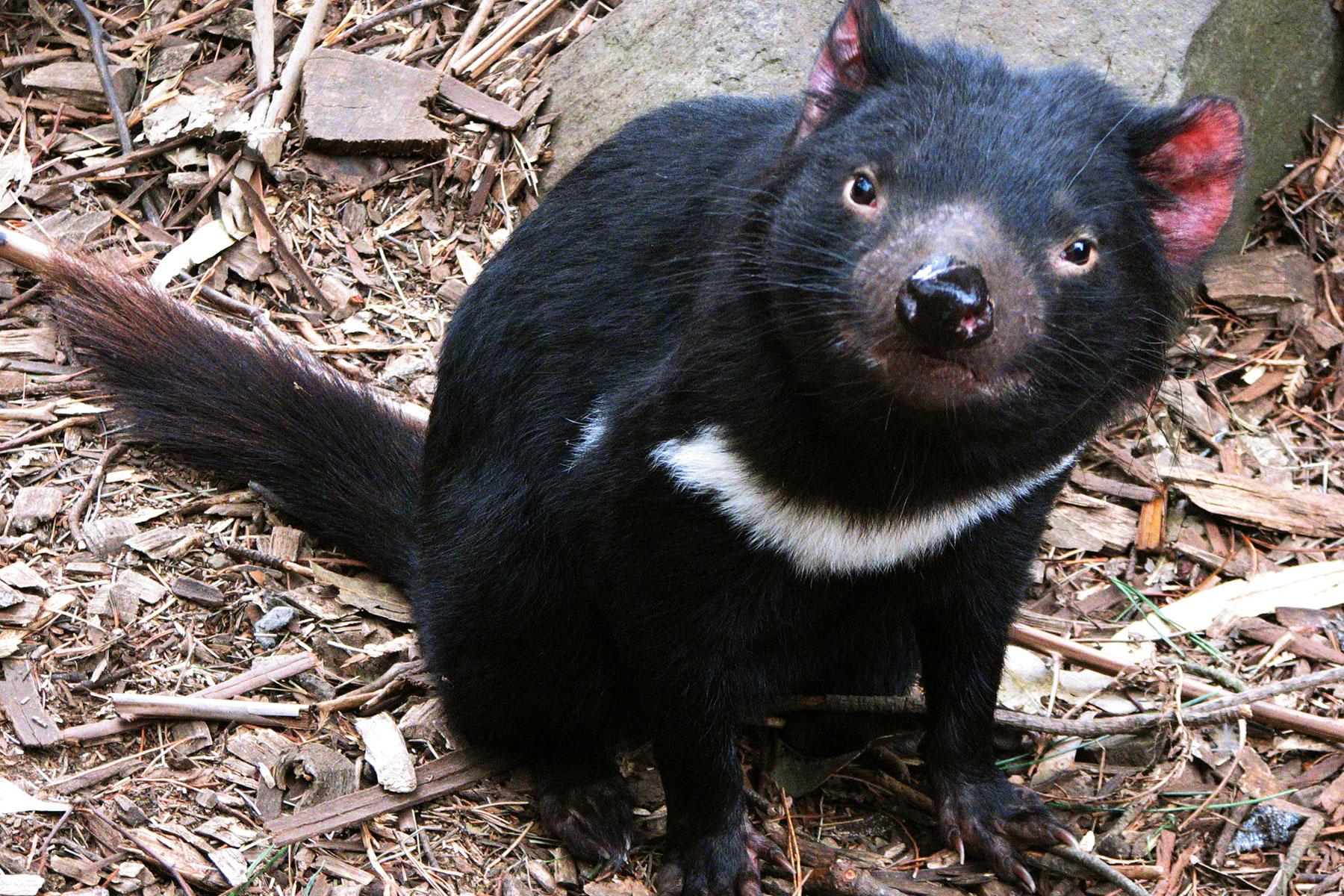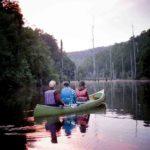Tasmanian devils are real, and they’re cuter and smarter than you think.
The true Tasmanian devil is not a tornado-spinning omnivore that can only be calmed by music, as Warner Bros. would have you believe. Yes, these small, meat-eating marsupials have a voracious appetite and a guttural growl, but they’re also nocturnal and shy. And their story is tragic: Their population as a whole is experiencing a devastating decline, thanks to a horrendous cancer called facial devil tumor disease. Thank goodness, there are wildlife centers and parks that are devoted to saving them, and these are your best chances to come face-to-face with the devil … and to learn a bit about them.
Tasmanian Devil Unzoo
WHERE: Taranna, near Port Arthur
You won’t find many fences at the “Unzoo,” the world’s first attempt to undo a former zoo. There is no boundary fence, so local wildlife—including wallabies, quolls, eagles, wattlebirds, pademelons, native hens, and, of course, Tasmanian devils—are free to come and go. In fact, the Tasmanian devils here are the last safe naturally wild devils that have been saved from devil facial tumor disease. Take a guided nature walk and see devils digging into a meal or stroll along bush trails on your own. Even better, take the Devil Tracker 4WD tour, which brings you into the forest on the daily devil check using special night vision cameras.
INSIDER TIPLook for the Great Tasmanian Devil Adventure, set to begin in 2018. It’s a day-long tour from Hobart that will visit the Tasman Peninsula, the last safe bastion for naturally wild Tasmanian devils; it will include a Devil Tracker Adventure, a visit to the Unzoo, and lunch, plus commentary along the way about the disease
Bonorong Wildlife Sanctuary
WHERE: Brighton
This inspiring little sanctuary near Hobart has been running a Tasmanian devil breeding program for more than 20 years. It’s the place to see and, on a private tour, feed them. The organization also runs Tasmania’s largest 24/7 wildlife rescue service, so you’ll also meet eastern quoll, shy Tasmanian bettong, tawny frogmouths, sugar gliders, and other recently rescued wild animals. For insight into these unique critters, be sure to take one of the guided wildlife tours.
INSIDER TIPSee the nocturnal animals on a private night tour.
Recommended Fodor’s Video
Trowunna Wildlife Park
WHERE: Mole Creek
If you need your questions about Tasmanian devils answered, Trowunna’s Devil Education and Research Center is a good place to start. Skulls, life-size cutouts, and research info provide a good 411. But there are live devils here too—the world’s largest heritage population of them, in fact. Be sure to take the daily interactive tour, which ends with a Tasmanian devil feeding.
INSIDER TIPTrowunna also serves as a sanctuary for transient and migratory animals, meaning there’s a chance to spot free-ranging kangaroos, wallabies, and pademelons as they hop through.
Devils@Cradle
WHERE: Cradle Mountain
Passionately devoted to the devils’ plight, this sanctuary near Cradle Mountain breeds Tasmanian devils, as well as eastern and spotted-tail quolls. And it’s one of the best places to gain insight into their lives.
You can wander around during the day (guided tours required at night), but it’s better to take a tour. The daytime Keepers Tour gives you the chance watch devils bask and forage; though the feeding frenzies eye-witnessed during the nighttime tours are a sight to behold—Tasmanian devils definitely do not have good table manners.
INSIDER TIPThe animals’ behavior varies from relaxed during the day to vocal and more active at night.
East Coast Natureworld
WHERE: Bicheno
This natural paradise began in 1981 as an 82-acre bird park around a lagoon. It has since expanded into a multi-award-winning wildlife park that rescues and rehabilitates all kinds of different animals, including the Tasmanian devil. You can get close to the devils, meet their keepers, and read about their struggles in the wild at Devil World. Here’s an interesting fact: Devil facial tumor disease isn’t the only reason why this species is endangered; domestic animals and road accidents add to their woes as well.
INSIDER TIPA Devils in the Dark tour departs from the East Coast Natureworld parking lot (and five other spots; check the website); it’s an unforgettable chance to see these nocturnal animals in their natural habitats.
Tasmania Zoo
WHERE: Launceston
The Tasmania Zoo, covering 900 acres of private native bush, has lots of native and exotic animals, including crocodiles, wombats, and monkeys, though most visitors have the Tasmanian devil on their minds. The zoo provides space for the important Devil’s Heaven, a conservation breeding program that has successfully bred devils for more than 10 years. It’s these devils that are showcased to curious animal lovers, with feedings offered three times a day.
INSIDER TIPThe zoo’s Encounter program enables you to get up-close and personal with some of the zoo animals, including meerkats, ring-tailed lemurs, koalas … and Tasmanian devils.
Wings Wildlife Park
WHERE: Gunns Plains
If you’re a gamer, you may already have heard about this wildlife park, which has been integrated into a new game by Riot Games revolving around two devils that beat facial tumor disease. Riot Games has also sponsored the park’s two latest Tasmanian devils, giving naming rights to game fans: Mechwolf and Xayah “The Rebel.” On a more serious note, the park, which has been operating since 1986, is deeply involved in rescuing and rehabilitating all kinds of animals, as well as running successful breeding programs for both devils and spotted-tail quolls.
INSIDER TIPWings is the largest wildlife park offering accommodation; stay in a rustic cabin or pitch a tent and wake to the tranquil sound of the murmuring creek.
Mountain Valley Wilderness
WHERE: Loongana
As dusk approaches in Tasmania’s northwest mountains, settle back into the cozy, firelit space of your rustic cabin at Mountain Valley Wilderness and enjoy one of the best wildlife shows on Earth.
Spotted-tail quolls, echidnas, and very likely devils themselves will appear on your doorstep, in search of food. This remote sanctuary featuring six log cabins in a tucked-away valley also has wallabies, possums, and, swimming around in the nearby creek, the bizarre-looking duckbilled platypus; interpretive platypus tours are offered at dusk.
INSIDER TIPMountain Valley Wilderness also possesses amazing native birdlife, showcasing everything from the tiny wren to the Tasmanian subspecies of the wedge tail eagle. Eleven of the twelve Tasmanian endemic birds inhabit the reserve.
In the Wild
Driving along Tasmania’s highways and byways, you’ll spot yellow and black signs with silhouettes of a toothy Tassie devil, alerting you to the possibility of their presence. Of course, they’re nocturnal and elusive, and they do their best not to be seen, so your chance of spotting one in all reality is rare. But you never know! The core habitat is eastern and northeastern Tasmania, though they can be found most anywhere except the highest altitudes.








